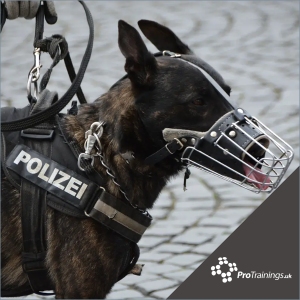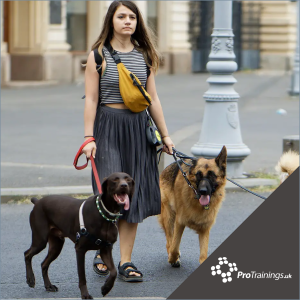Working in a dog related business, you will know how important it is to train your furry friends. Not only does it make them easier to live with, but it also ensures their safety and well-being. However, with so many dog training techniques out there, it can be overwhelming to know which one to choose. In this article, we’ll explore some of the most popular dog training methods and help you decide which one is right for you and your dogs.
One popular dog training method is clicker training. This technique uses a small, handheld device that makes a clicking sound to mark desired behaviour. Clicker training focuses on positive reinforcement, rewarding your dog for good behaviour rather than punishing them for bad behaviour. This method can be used to teach a wide range of behaviours, from basic obedience commands to more advanced tricks.
Another effective dog training technique is positive reinforcement. This method involves rewarding your dog with treats, praise, or attention when they exhibit good behaviour. Positive reinforcement is a humane and effective way to train your dog, as it encourages them to repeat behaviours that lead to positive outcomes. With consistent positive reinforcement, your dog can learn to behave in a way that makes both you and them happy.
Understanding Breed Characteristics
Why Breed Characteristics Matter In Training
When it comes to training your dog, understanding their breed characteristics is crucial. Each breed has unique traits that affect their behaviour, personality, and learning ability. By understanding these characteristics, you can tailor your training methods to suit your dog’s specific needs.
For example, some breeds are highly energetic and require lots of exercise, while others are more laid-back and prefer a quieter lifestyle. Some breeds are independent thinkers, making them more challenging to train, while others are eager to please and respond well to positive reinforcement.
Examples Of Breeds With Distinct Traits
Here are some examples of breeds with distinct traits that can affect their training:
Border Collie
Border Collies are highly intelligent and energetic dogs that excel in obedience training and agility. They have a strong herding instinct and require lots of mental and physical stimulation to stay happy and healthy.
Bulldog
Bulldogs are known for their stubbornness and require a firm but gentle approach to training. They are also prone to health issues, so it’s important to be mindful of their limitations and adjust your training accordingly.
Labrador Retriever
Labrador Retrievers are friendly, eager to please, and respond well to positive reinforcement. They are also highly food motivated, making them ideal candidates for clicker training.
Chihuahua
Chihuahuas are small but mighty dogs that can be easily intimidated. They require gentle but consistent training to build their confidence and prevent behavioural issues.
In conclusion, understanding your dog’s breed characteristics is essential for successful training. By tailoring your methods to suit their unique needs, you can build a strong bond with your dog and help them reach their full potential.
Positive Reinforcement Training Methods
Overview Of Positive Reinforcement
Positive reinforcement is a training method that involves rewarding good behaviour in dogs. This method focuses on rewarding your dog for doing something right, rather than punishing them for doing something wrong. Positive reinforcement training methods are based on the principle that dogs will repeat behaviours that are rewarded, and stop behaviours that are not rewarded.
Benefits Of Positive Reinforcement Training
There are several benefits to using positive reinforcement training methods for your dog. Here are some of the key benefits:
- Builds trust: Positive reinforcement training methods help build trust between you and your dog. By rewarding good behaviour, your dog learns to trust you and feel safe around you.
- Increases motivation: Positive reinforcement training methods help increase your dog’s motivation to learn and perform tasks. When your dog knows that there is a reward waiting for them, they are more likely to want to learn and perform well.
- Reduces stress: Punishing your dog for bad behaviour can cause stress and anxiety. Positive reinforcement training methods help reduce stress and create a more positive learning environment for your dog.
- Improves behaviour: Positive reinforcement training methods are effective in improving your dog’s behaviour. By rewarding good behaviour, your dog learns what is expected of them and is more likely to repeat that behaviour in the future.
Overall, positive reinforcement training methods are a great way to train your dog. By focusing on rewarding good behaviour, you can build trust, increase motivation, reduce stress, and improve your dog’s behaviour.
Tailoring Training Techniques For Different Breeds
Retrievers
Retrievers are known for their obedience and trainability, making them one of the easiest breeds to train. They are highly motivated by food and praise, so positive reinforcement is an effective training method. Clicker training is also a great way to train retrievers, as they respond well to the sound of the clicker.
When training retrievers, it’s important to focus on their natural instincts. Retrievers were bred to retrieve game, so incorporating retrieving games into their training can be highly effective. This can include playing fetch or hiding toys for them to find.
Terriers
Terriers are known for their independent nature, which can make them challenging to train. They are highly motivated by play and praise, so incorporating these into their training can be effective. Positive reinforcement is also a great training method for terriers.
When training terriers, it’s important to keep their high energy level in mind. Incorporating activities such as agility training or running can help keep them engaged and focused during training sessions.
Herding Breeds
Herding breeds are known for their intelligence and strong work ethic. They are highly motivated by praise and play, so positive reinforcement is an effective training method. Clicker training can also be effective for herding breeds.
When training herding breeds, it’s important to focus on their natural instincts. Herding breeds were bred to work, so incorporating activities such as agility training or herding games can be highly effective. It’s also important to provide them with mental stimulation, as they can become bored easily.
Overall, tailoring training techniques to the specific breed is important for effective dog training. By understanding the natural instincts and motivations of your dog’s breed, you can create a training plan that is both effective and enjoyable for your dog.
Common Training Challenges And Solutions
Addressing Stubbornness And Independence In Terriers
Terriers are known for their stubbornness and independence, which can make training difficult. To address this challenge, it’s important to establish yourself as the leader and to use positive reinforcement techniques. Here are some tips:
- Be patient and consistent in your training.
- Use high-value treats to motivate your terrier.
- Keep training sessions short and frequent.
- Use a firm but gentle tone of voice.
- Avoid punishment-based training methods.
Dealing With High Energy Levels In Retrievers
Retrievers are energetic dogs that require plenty of exercise and mental stimulation. If not properly trained, their energy can lead to destructive behaviour. Here are some solutions:
- Provide plenty of exercise and playtime.
- Use positive reinforcement techniques to channel their energy into productive activities.
- Teach them to fetch and retrieve.
- Use puzzle toys and other mentally stimulating activities.
Managing Herding Instincts In Herding Breeds
Herding breeds such as Border Collies and Australian Shepherds have strong herding instincts that can make training challenging. Here are some solutions:
- Provide plenty of exercise and mental stimulation.
- Teach them to focus on you and to respond to commands.
- Use positive reinforcement techniques to reinforce good behaviour.
- Use toys and other activities that simulate herding behaviour.
Remember, every dog is unique and may require different training methods. Be patient, consistent, and always use positive reinforcement techniques. With time and effort, you can train your dog to be a well-behaved and obedient companion.
Training Tips For Mixed Breed Dogs
If you have a mixed breed dog, you may find it challenging to train them due to their diverse traits. However, with the right approach, you can train your mixed breed dog effectively. Here are some training tips to help you get started.
Assessing The Dominant Breed Traits
Before you start training your mixed breed dog, you need to assess their dominant breed traits. This will help you understand their behaviour and personality better. You can do this by observing your dog’s behaviour and researching the dominant breed traits of the breeds in their mix.
For example, if your mixed breed dog has a dominant breed of a herding dog, they may have a high energy level and a strong desire to chase things. Understanding these traits will help you tailor your training methods to suit your dog’s needs.
Combining Training Techniques Tailored To The Dominant Breeds
Once you have assessed your dog’s dominant breed traits, you can start combining training techniques tailored to those breeds. For example, if your mixed breed dog has a dominant breed of a retriever, you can use clicker training to teach them to fetch and retrieve objects.
Similarly, if your mixed breed dog has a dominant breed of a terrier, you can use positive reinforcement to teach them to stop digging or barking excessively. By using training techniques tailored to your dog’s dominant breed traits, you can increase the effectiveness of your training.
Being Flexible And Adaptable In Training Methods
It’s essential to be flexible and adaptable in your training methods when training a mixed breed dog. Every dog is unique, and what works for one dog may not work for another. Therefore, you need to be open to trying different training methods until you find the one that works best for your dog.
For example, some mixed breed dogs respond well to treats as rewards, while others may prefer verbal praise or playtime. By being flexible and adaptable in your training methods, you can find what motivates your dog and use it to your advantage.
In conclusion, training a mixed breed dog requires patience, consistency and a tailored approach. By assessing your dog’s dominant breed traits, combining training techniques tailored to those breeds, and being flexible and adaptable in your training methods, you can train your mixed breed dog effectively.
Conclusion
Recap Of The Importance Of Understanding Breed Characteristics
In conclusion, understanding your dog’s breed characteristics is crucial for effective training. Different breeds have different temperaments, energy levels, and learning styles. By taking the time to learn about your dog’s breed, you can tailor your training techniques to suit their individual needs.
Reiterating The Effectiveness Of Positive Reinforcement Training
Positive reinforcement training is a highly effective method for training dogs. This technique involves rewarding good behaviour with treats, praise, or toys. By focusing on positive reinforcement, you can create a strong bond with your dog, build their confidence, and encourage them to learn new behaviours.
Encouragement For Readers To Embrace And Celebrate Their Dog’s Unique Characteristics In Training
Finally, it’s important to remember that each dog is unique, with their own personality, strengths, and weaknesses. Embracing your dog’s individuality is key to successful training. Celebrate their quirks and work with them to achieve their full potential. With patience, consistency, and positive reinforcement, you can train your dog to be a happy, well-behaved member of your family.








